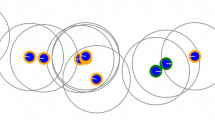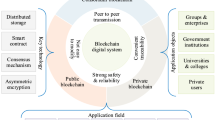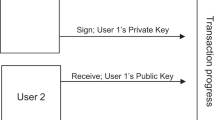Abstract
Blockchain technology generates and maintains an immutable digital ledger that records transactions between agents interacting in a peer-to-peer network. Initially developed for financial transactions between human agents, the technology could also be used across a broader spectrum of applications, providing transparency, security and trust without the need for a central authority. In this Perspective, we discuss how blockchain technology can enhance mobile multi-robot systems. This enhancement includes ensuring that autonomous robotic agents adhere to applicable laws, are identifiable and accountable for their behaviour, are capable of identifying and neutralizing malfunctioning robots and can actively participate in economic transactions for the exchange of goods and services. Discussing the first applications, we highlight the open challenges and describe the research directions that could reshape the mobile multi-robot research field in the coming decades.
Key points
-
Blockchain technology and smart contracts are a novel way to program distributed systems and can provide multi-robot systems with properties that will be fundamental for their real-world deployment.
-
There are different possible ways to integrate blockchain technology into a mobile multi-robot system: the blockchain can be hosted by the robots or it can be hosted externally; hybrid solutions are also conceivable.
-
Smart contracts can assist multi-robot systems by providing supervision, synchronized data storage capabilities and system-wide rules.
-
The behaviour of robots can be recorded in the blockchain, which is a tamper-proof database that allows for online fault detection and offline auditing.
-
Even though initial results are promising, the usage of blockchain technology in multi-robot systems needs substantial research before it can be successfully deployed.
This is a preview of subscription content, access via your institution
Access options
Subscribe to this journal
Receive 12 digital issues and online access to articles
$119.00 per year
only $9.92 per issue
Buy this article
- Purchase on Springer Link
- Instant access to full article PDF
Prices may be subject to local taxes which are calculated during checkout


Similar content being viewed by others
References
Dudek, G., Jenkin, M. R., Milios, E. & Wilkes, D. A taxonomy for multi-agent robotics. Autonomous Robot. 3, 375–397 (1996).
Parker, L. E. Multiple mobile robot systems. In Springer Handbook of Robotics 921–941 (Springer, 2008). This paper presents an accessible introduction to the foundations and early successes of mobile multi-robot systems.
Zhang, L., Zhang, Z., Siegwart, R. & Chung, J. J. Distributed PDOP coverage control: providing large-scale positioning service using a multi-robot system. IEEE Robot. Autom. Lett. 6, 2217–2224 (2021).
Mathews, N., Christensen, A. L., O’Grady, R., Mondada, F. & Dorigo, M. Mergeable nervous systems for robots. Nat. Commun. 8, 439 (2017).
Timmis, J., Ismail, A. R., Bjerknes, J. D. & Winfield, A. F. T. An immune-inspired swarm aggregation algorithm for self-healing swarm robotic systems. Biosystems 146, 60–76 (2016).
Mathews, N., Christensen, A. L., Stranieri, A., Scheidler, A. & Dorigo, M. Supervised morphogenesis: exploiting morphological flexibility of self-assembling multirobot systems through cooperation with aerial robots. Robot. Autonomous Syst. 112, 154–167 (2019).
Rizk, Y., Awad, M. & Tunstel, E. W. Cooperative heterogeneous multi-robot systems: a survey. ACM Comput. Surv. 52, https://doi.org/10.1145/3303848 (2019). This paper presents an overview of recent research achievements as well as open challenges in multi-robot systems.
Dorigo, M., Theraulaz, G. & Trianni, V. Swarm robotics: past, present and future. Proc. IEEE 109, 1152–1165 (2021). This review surveys the past, present and future of swarm robotics, discussing open challenges and research directions.
Wurman, P., D’Andrea, R. & Mountz, M. Coordinating hundreds of cooperative, autonomous vehicles in warehouses. AI Mag. 29, 9–20 (2008).
Yang, G.-Z. et al. The grand challenges of Science Robotics. Sci. Robot. 3, eaar7650 (2018).
Dorigo, M., Theraulaz, G. & Trianni, V. Reflections on the future of swarm robotics. Sci. Robot. 5, abe4385 (2020).
Wilson, J. et al. Trustworthy swarms. In Proc. First Int. Symp. Trustworthy Autonomous Systems https://doi.org/10.1145/3597512.3599705 (ACM, 2023).
Strobel, V., Castelló Ferrer, E. & Dorigo, M. Managing Byzantine robots via blockchain technology in a swarm robotics collective decision making scenario. In Proc. 17th Int. Conf. Autonomous Agents and Multiagent Systems (AAMAS 2018) 541–549 (IFAAMAS, 2018).
Castelló Ferrer, E., Hardjono, T., Pentland, A. & Dorigo, M. Secure and secret cooperation in robot swarms. Sci. Robot. 6, abf1538 (2021).
Hunt, E. R. & Hauert, S. A checklist for safe robot swarms. Nat. Mach. Intell. 2, 420–422 (2020). This paper presents a ten-item checklist to determine whether a robot swarm is safe.
Castelló Ferrer, E. If blockchain is the solution, robot security is the problem. Front. Blockchain 6, 1181820 (2023).
Strobel, V., Pacheco, A. & Dorigo, M. Robot swarms neutralize harmful Byzantine robots using a blockchain-based token economy. Sci. Robot. 8, eabm4636 (2023). This paper presents the first large-scale proof of concept of how to integrate blockchain technology into decentralized multi-robot systems.
Santos De Campos, M. G., Chanel, C. P., Chauffaut, C. & Lacan, J. Towards a blockchain-based multi-UAV surveillance system. Front. Robot. AI 8, 557692 (2021).
Grey, J., Godage, I. & Seneviratne, O. Swarm contracts: Smart contracts in robotic swarms with varying agent behavior. In Proc. 2020 IEEE Int. Conf. Blockchain (Blockchain 2020) 265–272 (IEEE, 2020).
Nakamoto, S. Bitcoin: A peer-to-peer electronic cash system. https://bitcoin.org/en/bitcoin-paper (2008). This article describes the first practical implementation of a consensus-based decentralized digital currency that overcomes the Byzantine generals problem and introduces blockchain technology as a ledger for storing transactions of the cryptocurrency Bitcoin.
Buterin, V. A next-generation smart contract and decentralized application platform. Ethereum Project white paper. Ethereum https://ethereum.org/en/whitepaper/ (2014). In this work the blockchain framework Ethereum generalizes the idea behind a blockchain from a store of value to a decentralized computing system, enabling smart contracts.
Peña Queralta, J. et al. Blockchain and emerging distributed ledger technologies for decentralized multi-robot systems. Curr. Robot. Rep. 4, 43–54 (2023).
Aditya, S., Singh, R., Singh, P. K. & Kalla, A. A survey on blockchain in robotics: issues, opportunities, challenges and future directions. J. Netw. Computer Appl. 196, 103245 (2021).
Peña Queralta, J. & Westerlund, T. Blockchain for mobile edge computing: Consensus mechanisms and scalability. In Mobile Edge Computing 333–357 (Springer, 2021).
Singh, A. et al. Sidechain technologies in blockchain networks: an examination and state-of-the-art review. J. Netw. Comput. Appl. 149, 102471 (2020).
Strobel, V. & Dorigo, M. Blockchain technology for robot swarms: A shared knowledge and reputation management system for collective estimation. In Swarm Intelligence—Proc. ANTS 2018—11th Int. Conf. 425–426 (Springer, 2018). [Lecture Notes in Computer Science 11172].
Strobel, V., Castelló Ferrer, E. & Dorigo, M. Blockchain technology secures robot swarms: a comparison of consensus protocols and their resilience to Byzantine robots. Front. Robot. AI 7, 54 (2020).
Pacheco, A., Strobel, V. & Dorigo, M. A blockchain-controlled physical robot swarm communicating via an ad-hoc network. In Swarm Intelligence—Proc. ANTS 2020—12th Int. Conf. 3–15 (Springer, 2020). [Lecture Notes in Computer Science 12421].
Pacheco, A., Strobel, V., Reina, A. & Dorigo, M. Real-time coordination of a foraging robot swarm using blockchain smart contracts. In Swarm Intelligence—Proc. ANTS 2022—13th Int. Conf. 196–208 (Springer, 2022). [Lecture Notes in Computer Science 13491].
Castelló Ferrer, E., Jiménez, E., Lopez-Presa, J. L. & Martín-Rueda, J. Following leaders in Byzantine multirobot systems by using blockchain technology. IEEE Trans. Robot. 38, 1101–1117 (2021).
Alsamhi, S. H. et al. Blockchain-empowered security and energy efficiency of drone swarm consensus for environment exploration. IEEE Trans. Green. Commun. Netw. 7, 328–338 (2023).
Mokhtar, A., Murphy, N. & Bruton, J. Blockchain-based multi-robot path planning. In Proc. 5th IEEE World Forum on Internet of Things (WF–IoT 2019) 584–589 (IEEE, 2019).
Grey, J., Seneviratne, O. & Godage, I. Blockchain-based mechanism for robotic cooperation through incentives: Prototype application in warehouse automation. In Proc. 2021 IEEE Int. Conf. Blockchain (Blockchain 2021) 597–604 (IEEE, 2021).
Mallikarachchi, S., Dai, C., Seneviratne, O. & Godage, I. Managing collaborative tasks within heterogeneous robotic swarms using swarm contracts. In Proc. 4th IEEE Int. Conf. Decentralized Applications and Infrastructures (DAPPS 2022) 48–55 (IEEE, 2022).
Castelló Ferrer, E., Rudovic, O., Hardjono, T. & Pentland, A. Robochain: A secure data-sharing framework for human-robot interaction. In Proc. 10th Int. Conf. Health, Telemedicine, and Social Medicine (eTELEMED 2018) 124–130 (IARIA, 2018).
Alsamhi, S. H. & Lee, B. Blockchain-empowered multi-robot collaboration to fight COVID-19 and future pandemics. IEEE Access. 9, 44173–44197 (2021).
Kapitonov, A., Lonshakov, S., Bulatov, V., Montazam, B. K. & White, J. Robot-as-a-service: from cloud to peering technologies. Front. Robot. AI 8, 560829 (2021).
Kapitonov, A., Lonshakov, S., Krupenkin, A. & Berman, I. Blockchain-based protocol of autonomous business activity for multi-agent systems consisting of UAVs. In 2017 Workshop on Research, Education and Development of Unmanned Aerial Systems (RED-UAS) 84–89 (IEEE, 2017).
Ongaro, D. & Ousterhout, J. In search of an understandable consensus algorithm. In 2014 USENIX Annu. Technical Conf. (USENIX ATC 14) 305–319 (2014).
Androulaki, E. et al. Hyperledger Fabric: A distributed operating system for permissioned blockchains. In Proc. 13th EuroSys Conf. 1–15 (ACM, 2018).
Salimi, S., Peña Queralta, J. & Westerlund, T. Hyperledger Fabric blockchain and ROS 2 integration for autonomous mobile robots. In 2023 IEEE/SICE Int. Symp. System Integration 1–8 (IEEE, 2023).
Wardega, K., von Hippel, M., Tron, R., Nita-Rotaru, C. & Li, W. Byzantine resilience at swarm scale: A Decentralized Blocklist Protocol from inter-robot accusations. In Proc. 2023 Int. Conf. Autonomous Agents and Multiagent Systems (AAMAS ’23) 1430–1438 (IFAAMAS, 2023).
Hoffmann, F. Challenges of proof-of-useful-work (PoUW). In Proc. IEEE 1st Global Emerging Technology Blockchain Forum: Blockchain & Beyond (iGETblockchain 2022) https://doi.org/10.1109/iGETblockchain56591.2022.10087185 (IEEE, 2022).
Tran, J. A. et al. SwarmDAG: a partition tolerant distributed ledger protocol for swarm robotics. Ledger 4, https://doi.org/10.5195/ledger.2019.174 (2019).
Keramat, F., Peña Queralta, J. & Westerlund, T. Partition-tolerant and Byzantine-tolerant decision making for distributed robotic systems with IOTA and ROS2. IEEE Internet Things J. 10, 12985–12998 (2023).
Salimpour, S., Keramat, F., Peña Queralta, J. & Westerlund, T. Decentralized vision-based Byzantine agent detection in multi-robot systems with IOTA smart contracts. In Foundations and Practice of Security: 15th Int. Symp., FPS 2022, Revised Selected Papers 322–337 (Springer, 2023).
Al-Breiki, H., Rehman, M. H. U., Salah, K. & Svetinovic, D. Trustworthy blockchain oracles: review, comparison, and open research challenges. IEEE Access. 8, 85675–85685 (2020).
Mühlberger, R. et al. Foundational oracle patterns: Connecting blockchain to the off-chain world. In Business Process Management: Blockchain and Robotic Process Automation Forum 35–51 (Springer, 2020).
Zhao, H. et al. A generic framework for Byzantine-tolerant consensus achievement in robot swarms. In IEEE/RSJ Int. Conf. Intelligent Robots and Systems—IROS 2023 8839–8846 (IEEE, 2023).
Valentini, G., Brambilla, D., Hamann, H. & Dorigo, M. Collective perception of environmental features in a robot swarm. In Swarm Intelligence—Proc. ANTS 2016—10th Int. Conf. 65–76 (Springer, 2016). [Lecture Notes in Computer Science 9882].
Brekke, J. K. & Alsindi, W. Z. Cryptoeconomics. Internet Policy Rev. 10, https://doi.org/10.14763/2021.2.1553 (2021).
Andola, N., Raghav, Yadav, V. K., Venkatesan, S. & Verma, S. Anonymity on blockchain based e-cash protocols—a survey. Computer Sci. Rev. 40, 100394 (2021).
Conoscenti, M., Vetrò, A. & De Martin, J. C. Blockchain for the Internet of Things: A systematic literature review. In Proc. 13th IEEE/ACS Int. Conf. Computer Systems and Applications (AICCSA 2016) 1–6 (2016).
Raymond, E. S. The Cathedral and the Bazaar: Musings on Linux and Open Source by an Accidental Revolutionary (O’Reilly Media, 1999).
Rodler, M., Li, W., Karame, G. O. & Davi, L. EVMPatch: Timely and automated patching of Ethereum smart contracts. In Proc. 30th USENIX Security Symposium (USENIX Security 21) 1289–1306 (USENIX Association, 2021).
DuPont, Q. Experiments in algorithmic governance: A history and ethnography of ‘The DAO,’ a failed decentralized autonomous organization. In Bitcoin and Beyond: Cryptocurrencies, Blockchains, and Global Governance 157–177 (Routledge, 2017).
Sabt, M., Achemlal, M., & Bouabdallah, A. Trusted Execution Environment: What it is, and what it is not. In Proc. 14th IEEE Int. Conf. Trust, Security and Privacy in Computing and Communications 57–64 (IEEE Press, 2015).
Wöhrer, M. & Zdun, U. Design patterns for smart contracts in the Ethereum ecosystem. In Proc. IEEE 2018 Int. Congress on Cybermatics 1513–1520 (IEEE, 2018).
Van Calck, L., Pacheco, A., Strobel, V., Dorigo, M. & Reina, A. A blockchain-based information market to incentivise cooperation in swarms of self-interested robots. Sci. Rep. 13, 20417 (2023).
Hassan, S. & De Filippi, P. Decentralized autonomous organization. Internet Policy Rev. 10, https://doi.org/10.14763/2021.2.1556 (2021).
Wang, S. et al. Decentralized autonomous organizations: concept, model, and applications. IEEE Trans. Computational Soc. Syst. 6, 870–878 (2019).
Cardenas, I. S., May, J. B. & Kim, J.-H. AutomataDAO: A blockchain-based data marketplace for interactive robot and IoT data exchanges using Ethermint and state channels. In Blockchain Technology for IoT Applications 17–38 (Springer, 2021).
Reina, A. Robot teams stay safe with blockchains. Nat. Mach. Intell. 2, 240–241 (2020).
Danilov, K., Rezin, R., Afanasyev, I. & Kolotov, A. Towards blockchain-based Robonomics: Autonomous agents behavior validation. In Proc 9th IEEE Int Conf Intelligent Systems (IS 2018) 222–227 (IEEE, 2018).
Abou Jaoude, J. & Saade, R. G. Blockchain applications—usage in different domains. IEEE Access. 7, 45360–45381 (2019).
Castelló Ferrer, E. et al. Gaka-chu: A self-employed autonomous robot artist. In Proc. 2023 IEEE Int. Conf. Robotics and Automation (ICRA 2023) 11583–11589 (IEEE, 2023).
Lajoie, P.-Y., Ramtoula, B., Wu, F. & Beltrame, G. Towards collaborative simultaneous localization and mapping: a survey of the current research landscape. Field Robotics 2, 971–1000 (2022).
Chong, C.-Y., Chang, K.-C. & Mori, S. A review of forty years of distributed estimation. In Proc. 21st Int. Conf. Information Fusion (Fusion 2018) 1–8 (IEEE, 2018).
Douceur, J. R. The Sybil attack. In 1st International Workshop on Peer-to-Peer Systems 251–260 (Springer, 2002). [Lecture Notes in Computer Science 2429].
Saeedi, S., Trentini, M., Seto, M. & Li, H. Multiple‐robot simultaneous localization and mapping: a review. J. Field Robot. 33, 3–46 (2016).
Kegeleirs, M., Grisetti, G. & Birattari, M. Swarm SLAM: challenges and perspectives. Front. Robot. AI 8, 618268 (2021).
Majcherczyk, N., Srishankar, N. & Pinciroli, C. Flow-FL: Data-driven federated learning for spatio-temporal predictions in multi-robot systems. In Proc. 2021 IEEE Int. Conf. Robotics and Automation (ICRA 2021) 8836–8842 (IEEE, 2021).
Zakir, R., Dorigo, M. & Reina, A. Robot swarms break decision deadlocks in collective perception through cross-inhibition. In Swarm Intelligence—Proc. ANTS 2022—3th Int. Conf. 209–221 (Springer, 2022). [Lecture Notes in Computer Science 13491].
Castelló Ferrer, E. The blockchain: A new framework for robotic swarm systems. In Proc. Future Technol. Conf. (FTC 2018) Vol. 881 1037–1058 (Springer, 2018).
Maskin, E. Introduction to mechanism design and implementation. Transnatl. Corporations Rev. 11, 1–6 (2019).
White, R., Caiazza, G., Cortesi, A., Cho, Y. & Christensen, H. Black block recorder: immutable black box logging for robots via blockchain. IEEE J. Robot. Autom. 4, 3812–3819 (2019).
Lopes, V. & Alexandre, L. A. Detecting robotic anomalies using Robotchain. In IEEE Int. Conf. Autonomous Robot Systems and Competitions (ICARSC 2019) 174–179 (IEEE, 2019).
Lopes, V., Pereira, N., Fernandes, M. & Alexandre, L. A. A time-segmented consortium blockchain for robotic event registration. In Proc. 3rd Int. Conf. Blockchain Technology (ICBCT 2021) 117–122 (ACM, 2021).
Talamali, M. S., Saha, A., Marshall, J. A. R. & Reina, A. When less is more: robot swarms adapt better to changes with constrained communication. Sci. Robot. 6, eabf1416 (2021).
Zhu W. et al. Self-organizing nervous systems for robot swarms. Preprint at arXiv https://doi.org/10.48550/arXiv.2401.13103 (2024).
Dorigo, M., Birattari, M. & Brambilla, M. Swarm robotics. Scholarpedia 9, 1463 (2014).
Hamann, H. Swarm Robotics: A Formal Approach (Springer, 2018).
Gielis, J., Shankar, A. & Prorok, A. A critical review of communications in multi-robot systems. Curr. Robot. Rep. 3, 213–225 (2022).
Demir, K. A., Döven, G. & Sezen, B. Industry 5.0 and human-robot co-working. Procedia Comput. Sci. 158, 688–695 (2019).
Lamport, L., Shostak, R. & Pease, M. The Byzantine generals problem. ACM Trans. Program. Lang. Syst. 4, 382–401 (1982). This foundational paper introduces the Byzantine generals problem — a thought experiment that highlights the challenges of achieving a consensus in distributed networks where the agents (the ‘Byzantine generals’) are not necessarily reliable.
Castro, M. & Liskov, B. Practical Byzantine fault tolerance and proactive recovery. ACM Trans. Computer Syst. 20, 398–461 (2002).
Dwork, C., Lynch, N. & Stockmeyer, L. Consensus in the presence of partial synchrony. J. ACM 35, 288–323 (1988).
Chaum, D., Fiat, A. & Naor, M. Untraceable electronic cash. In Advances in Cryptology—Crypto ’88 (Springer, 1990). [Lecture Notes in Computer Science 403].
Dwork, C. & Naor, M. Pricing via processing or combatting junk mail. In Proc. Annu. Int. Cryptology Conf.—Advances in Cryptology (Crypto’ 92) 139–147 (Springer, 1992). [Lecture Notes in Computer Science 740].
Acknowledgements
This work was supported by the Program of Concerted Research Actions (ARC) of the Université Libre de Bruxelles and by the Service Public de Wallonie Recherche under grant n° 2010235 — ARIAC by DigitalWallonia4.ai. M.D., A.R. and V.S. acknowledge support from the Belgian F.R.S.-FNRS. A.R. also acknowledges support by the Deutsche Forschungsgemeinschaft (DFG; German Research Foundation) under Germany’s Excellence Strategy — EXC 2117-422037984.
Author information
Authors and Affiliations
Contributions
M.D. and V.S. wrote the manuscript. All authors discussed the scope of the article, contributed with ideas and revised the manuscript.
Corresponding authors
Ethics declarations
Competing interests
The authors declare that they do not have any competing interests.
Peer review
Peer review information
Nature Reviews Electrical Engineering thanks Erol Sahin and the other anonymous reviewer(s) for their contribution to the peer review of this work.
Additional information
Publisher’s note Springer Nature remains neutral with regard to jurisdictional claims in published maps and institutional affiliations.
Related links
Hyperledger: https://www.hyperledger.org
IOTA: https://www.iota.org/
Monero: https://www.getmonero.org/
Oasis Network: https://oasisprotocol.org/
PoA consensus mechanism: http://eips.ethereum.org/EIPS/eip-225
PoS consensus mechanism: http://ethereum.org/en/developers/docs/consensus-mechanisms/pos
Secret Network: https://scrt.network/
Stellar Consensus Protocol: https://stellar.org/learn/stellar-consensus-protocol
Rights and permissions
Springer Nature or its licensor (e.g. a society or other partner) holds exclusive rights to this article under a publishing agreement with the author(s) or other rightsholder(s); author self-archiving of the accepted manuscript version of this article is solely governed by the terms of such publishing agreement and applicable law.
About this article
Cite this article
Dorigo, M., Pacheco, A., Reina, A. et al. Blockchain technology for mobile multi-robot systems. Nat Rev Electr Eng 1, 264–274 (2024). https://doi.org/10.1038/s44287-024-00034-9
Accepted:
Published:
Issue Date:
DOI: https://doi.org/10.1038/s44287-024-00034-9



